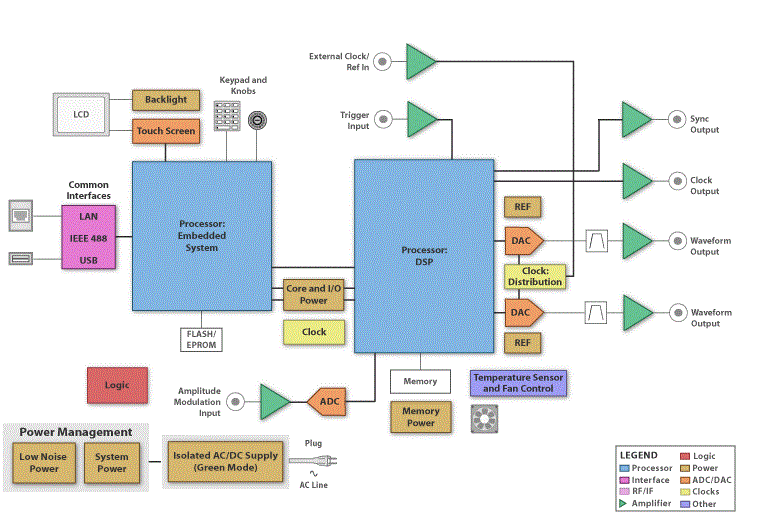The Signal/Waveform Generator creates sine, square, triangle, and noise signals in a repeated or triggered fashion to help design, test, or troubleshoot an electrical device. The system block diagram presented below includes on board signal synthesis and control via a DSP and microcontroller, respectively. A General Purpose Interface Bus (GPIB) and RS-232 port are typical communication options for signal generators but higher speed interface options are available through Local-Area Network (LAN), Universal Serial Bus (USB), and Peripheral Component Interconnects (PCI). The management of interface signals and other simple control functions is typically driven by a microcontroller or simple embedded processor while the intensive signal synthesis and waveform generation is driven by a digital signal processor (DSP) (Field-Programmable Gate Arrays (FPGAs) or custom Application-Specific Integrated Circuits (ASICs) are other options).
Signal Chain: While a DSP can synthesize high speed digital signals, the Digital to Analog Converter (DAC) must match the bandwidth of the digital signal while reducing noise during signal conversion. Although precision DACs yield high Signal to Noise Ratio (SNR), Effective Number of Bits (ENOB), and fast settling times, high speed DACs provide faster update rates, wider bandwidth, and higher output current. A high performance, low jitter (or low phase noise) clock feeds the DACs to allow accurate sampling (i.e. TI's CDCM7005). The output amplifiers must support the bandwidth of the signal provided by the DAC, show low distortion, and provide fast settling time to maintain signal integrity as in TI’s OPA8xx and THS3xx families.
Power: System power options range from switching power supplies with wide input range to low drop out regulators with high Power Supply Rejection Ratio (PSRR), fast transient response, low noise, and fast start up time. Further noise mitigation can be accomplished via local regulation layout techniques. On the processor power side, fast transient responses, a programmable soft start and power enable are important power options to consider and are available in TI's TPS74xxx family.
Texas Instruments has launched a support tool enabling designers to rapidly evaluate system signal chain performance. The development kit (evaluation module TSW3070) simplifies the interface between high-speed DACs and amplifiers (wide band versus high swing with enhanced AC performance) and includes clocking and power management to further ease design. In addition, the tool provides customers with the flexibility to implement alternative design configurations via an easy-to-use graphical user interface (GUI).

Featured Parts
- ADC121S101 – Single Channel, 0.5 to 1 Msps, 12-Bit A/D Converter
- DAC34SH84 – Quad-Channel, 16-Bit, 1.5 GSPS Digital-to-Analog Converter (DAC)
- INA230AIRGTR – Basic over current protection on power supply
- LMK04828 – Ultra Low Jitter Synthesizer and Jitter Cleaner
- MSP430FG4616 – Ultra-Low power 16-bit microcontroller offering 512KB Flash, USB interface, 12-bit ADC, dual DAC’s, 160 segment LCD driver
- OPA695/2695 – Ultra-Wideband, Current-Feedback Operational Amplifier with Disable
- THS3091/95 – Single- High-Voltage, Low Distortion, Current-Feedback Operational Amplifier
- TMP102AIDRLR– basic – Low Power Digital Temperature Sensor with SMBus/Two-Wire Serial Interface in SOT563
Click here for more information on Industrial Solutions

Buy the Featured Parts Now at Mouser Electronics
Advertisement
Learn more about Texas Instruments





